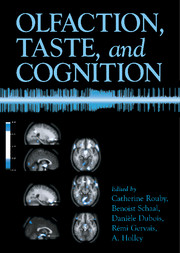Book contents
- Frontmatter
- Contents
- Contributors
- Preface
- Acknowledgments
- A Tribute to Edmond Roudnitska
- OLFACTION, TASTE, AND COGNITION
- Section 1 A Specific Type of Cognition
- Section 2 Knowledge and Languages
- Section 3 Emotion
- Section 4 Memory
- 13 Testing Odor Memory: Incidental versus Intentional Learning, Implicit versus Explicit Memory
- 14 Odor Memory: A Memory Systems Approach
- 15 Repetition Priming in Odor Memory
- 16 Odor Memory in Alzheimer's Disease
- 17 Development of Odor Naming and Odor Memory from Childhood to Young Adulthood
- Section 5 Neural Bases
- Section 6 Individual Variations
- Index
- References
14 - Odor Memory: A Memory Systems Approach
Published online by Cambridge University Press: 21 September 2009
- Frontmatter
- Contents
- Contributors
- Preface
- Acknowledgments
- A Tribute to Edmond Roudnitska
- OLFACTION, TASTE, AND COGNITION
- Section 1 A Specific Type of Cognition
- Section 2 Knowledge and Languages
- Section 3 Emotion
- Section 4 Memory
- 13 Testing Odor Memory: Incidental versus Intentional Learning, Implicit versus Explicit Memory
- 14 Odor Memory: A Memory Systems Approach
- 15 Repetition Priming in Odor Memory
- 16 Odor Memory in Alzheimer's Disease
- 17 Development of Odor Naming and Odor Memory from Childhood to Young Adulthood
- Section 5 Neural Bases
- Section 6 Individual Variations
- Index
- References
Summary
Research focusing on human memory suggests that memory is not a single or unitary faculty of the mind. Instead, it can be conceived of as a variety of distinct and dissociable processes and systems that are subserved by particular constellations of neural networks that mediate different forms of learning (e.g., Gabrieli et al., 1995; Tulving, 1995; McDonald, Ergis, and Winocur, 1999).
One categorical distinction within human memory is that between declarative memory and non-declarative memory (Tulving, 1995). According to this division, non-declarative memory is characterized by unintentional learning, or learning without awareness, and by inability to access conscious recall. This form of memory is manifested in multiple dissociable processes and is measured in terms of changes in performance (produced by conditioning and priming) in the learning of motor skills (e.g., Schacter, 1992). In contrast, declarative memory can be conceptualized as learning with awareness and refers to the acquisition and retention of information about events and facts, and is typically assessed by accuracy in tests of recall and recognition. The available evidence suggests that medial temporal/diencephalic structures are critical for the integrity of declarative memory, whereas non-declarative forms of memory rely on other brain areas, such as occipital structures (visual priming) (Gabrieli et al., 1995) and basal ganglia (procedural memory) (Heindel et al., 1989).
Although based on hypothetical constructs and still under considerable debate, the view that human memory is composed of at least five different systems has been highly influential (e.g., Nyberg and Tulving, 1996; Roediger, Buckner, and McDermott, 1999).
Information
- Type
- Chapter
- Information
- Olfaction, Taste, and Cognition , pp. 231 - 245Publisher: Cambridge University PressPrint publication year: 2002
References
Accessibility standard: Unknown
Why this information is here
This section outlines the accessibility features of this content - including support for screen readers, full keyboard navigation and high-contrast display options. This may not be relevant for you.Accessibility Information
- 11
- Cited by
